Contents
The Riesling grape is a white industrial variety of crop that is used to produce quality wines with a high sugar content ranging from dry to dessert. But in any case, the increased acidity of the drink remains. Also, this variety is suitable for juice production. Riesling shows increased productivity when grown in temperate regions. To get a good harvest, you need to follow some features of agricultural technology.
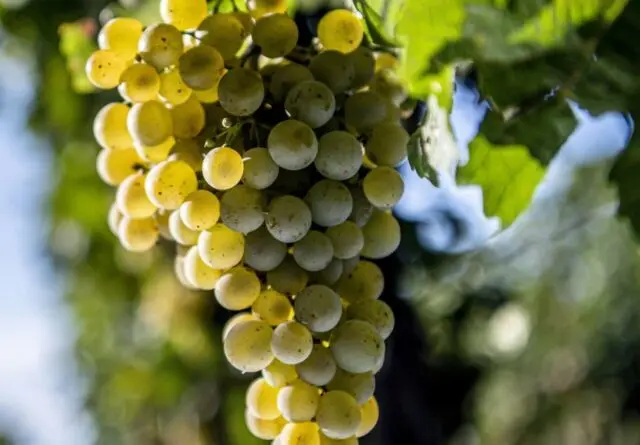
Riesling is often referred to as the “king of the vineyard”
History of breeding
Riesling is an old European variety, the first mention of which dates back to 1435. The homeland of this grape is the Rhine region of Germany. The conducted DNA study showed that it was obtained on the basis of the rare Goué blanc and the hybrid form of Traminer. It is not known for certain who is its originator.
Description of the Riesling grape variety
Riesling bushes are characterized by medium vigor. When growing a variety without shelter, it is recommended to form on a high trunk 1,2 m high with a freely hanging or tied one-year growth. If it is necessary to warm the vines for the winter, preference should be given to multi-armed fan plantings.
bunches
Riesling grapes have small clusters. Their length reaches 14 cm, and the width is 8 cm. The structure of the Riesling clusters can vary from loose to dense, and the shape is cylindrical or conical. Their average weight is 80-100 g. The length of the comb does not exceed 3 cm.
Berries
The fruits are medium in size, their diameter is 11-15 mm. The shape of the berries is round. The skin is dense, thin with a wax coating. When ripe, the fruits become light green in color, and rare small brown dots appear on their surface. The pulp is juicy, soft. Each berry has 2-4 seeds.
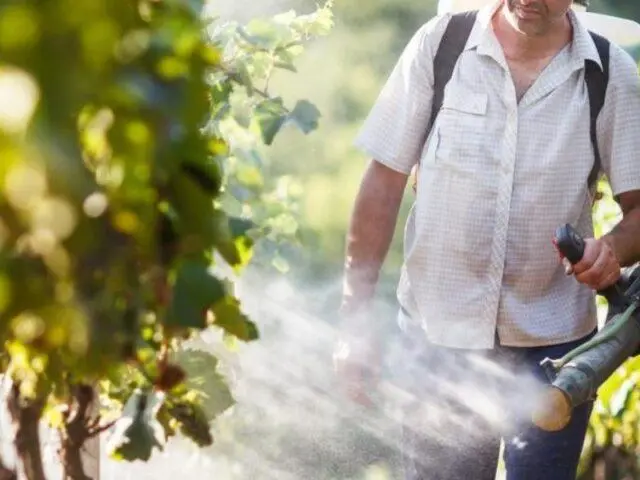
When processing fruits, the juice yield is 80% of the total mass
Vine
Riesling grapes form many young shoots and need annual pruning. The vine ripens well during the season. This can be determined by the shade, which changes from reddish to light brown. But at the same time, the nodes have a darker shade than the internodes. About 45% of Riesling replacement buds are fertile.
The leaves are medium in size, three or five lobed. A characteristic feature of the variety is strongly wrinkled funnel-shaped rough plates with convex veins and felt pubescence on the reverse side. The cuts in the upper part of the leaves are medium in size, and at the base they are small. The petiole notch on the plates is closed and open. In the first case, it has an elliptical lumen, and in the second, it has a narrow mouth. Riesling petioles are no longer than the main leaf vein. They have an anthocyanin tint.
The teeth along the edge of the plates with a wide base are triangular, and closer to the tip they become domed.
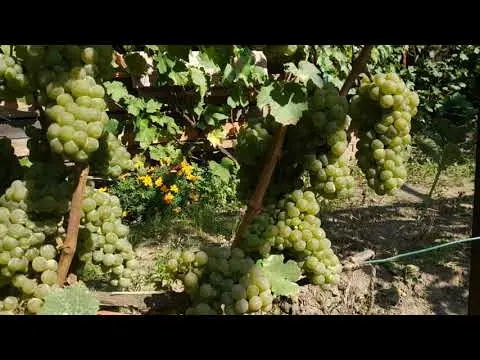
With the advent of autumn, the leaves of this grape acquire a bright yellow hue.
Characteristics of Riesling grapes
To evaluate the productivity of a variety, you need to study its characteristics. Also, this information will help determine the favorable conditions for its cultivation and avoid mistakes in care.
Maturation period
This species has a late maturity. According to the description, the growing season for the Rhine Riesling grape lasts 150-160 days from the moment the buds open. Clusters ripen at the end of September at a sum of active temperatures of 28-29 °C.
Riesling grape yield per bush
Grapes are not very productive. The number of fruitful shoots on a bush is 87%. At the same time, no more than two bunches are formed on each of them. The yield level is 157 c/ha.
Taste of Riesling grapes
This grape is characterized by a pleasant harmonious taste. The tasting score is the maximum. On the palate there are shades of fresh fruit with a slight aroma of flowers and herbs.
Young wine based on Riesling is distinguished by the tone of fresh apples, citrus fruits. As it matures, its aroma acquires notes of honey and withered flowers. In “age” drinks, mineral impurities appear, causing an association with oil or acetone.
Where grows
Riesling is grown in many European countries that produce fine wines. Also, the variety is common in New Zealand, Australia, South Africa, USA, Canada, Moldova, Ukraine, Our Country. The most favorable for it are the climatic conditions of the northern wine-growing regions.
In Our Country, Riesling grapes are recommended to be grown in the middle zone. In this case, the bunches have time to accumulate sweetness in the last warm days of autumn.
Frost resistance
The variety has an average level of frost resistance. Riesling does not suffer from a short-term drop in temperature to -20 ° C. Also, the grapes are not very susceptible to spring return frosts, since the growing season begins much later for it than for other types of crops.
Drought tolerance
Riesling requires regular watering and does not respond well to lack of moisture in the soil. But at the same time, the vine does not tolerate long-term stagnation of water. Therefore, when growing a variety, it is necessary to provide dosed watering, avoiding drought.
Disease resistance
Riesling does not have disease resistance, which complicates the care of this grape variety. In prolonged wet weather, the plant suffers from gray rot. Also, the variety is susceptible to damage by oidium, bacterial cancer, but is not very susceptible to mildew. In this regard, the grower must regularly process the grapes, using contact and systemic fungicides, in order to provide reliable protection against pathogenic microflora.
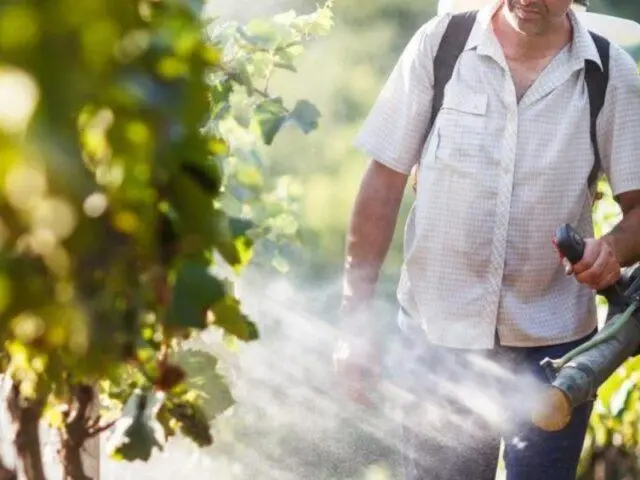
Spray Riesling plantings with fungicides should be at least 4-5 times per season.
This grape is also susceptible to attack by phylloxera and grape leafworm.
keeping quality
The harvested crop is suitable for transportation. It can also be stored fresh for 2-3 months in a cool room.
Advantages and disadvantages
Riesling, like all grape varieties, has strengths and weaknesses. Before giving preference to him, you should familiarize yourself with them.
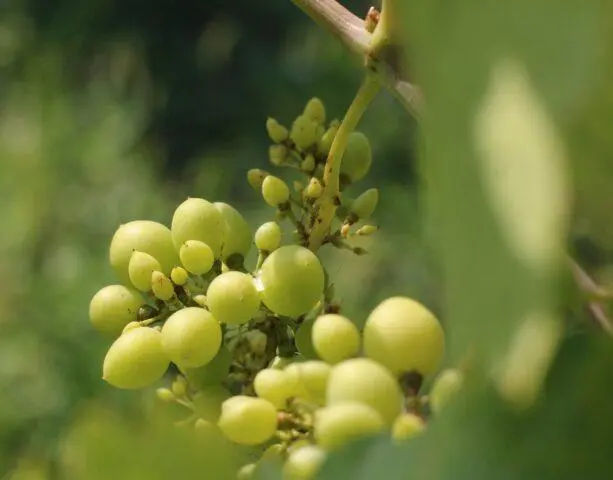
Riesling has a penchant for pea berries
Main advantages:
- frost resistance;
- good aging of the vine;
- suitable for transportation and storage;
- suitable for making wine, juice;
- does not suffer from spring return frosts;
- has a relative resistance to mildew;
- The fragrance combines floral, herbaceous, fruity notes.
Disadvantages:
- the variety is demanding on soil moisture;
- long and slow ripening period of clusters;
- susceptible to damage by oidium, bacterial cancer, leafworm, phylloxera.
Peculiarities of growing
The removal of seedlings should be carried out in the spring so that they can get stronger during the season. Experts recommend planting Riesling grapes on gentle slopes on the south side of the site. At the same time, the variety responds well to soil with a high content of lime. Plants should be placed taking into account the fact that each will require at least 5 square meters. m for full development.
After planting, it is necessary to monitor the soil moisture. The seedling should be watered regularly for the first month as the topsoil dries out. Then moistening is carried out once every ten days in the absence of rain. Mature Riesling grape bushes also need to be watered constantly, preventing the soil from drying out at their base. Moisture is especially important for them before flowering, during the formation of the ovary and before winter.
Riesling does not need regular feeding. It is enough to fertilize the vine twice a season with complex mineral mixtures with a high content of potassium and phosphorus. Feeding this variety with organic matter is not recommended.
Riesling grapes need annual pruning. This allows you to normalize the load on the bush. Shorten fruit shoots should be up to 6-8 eyes.
If it is necessary to warm the plant for the winter, it is recommended to initially sprinkle it with earth at the base, and then remove the shoots from the support and lay them on the ground, after placing a spruce branch under them. From above, the grapes should be covered with agrofibre, and then with a film and fix the shelter.
Conclusion
The Riesling grape is an ancient variety of culture that is widely used in winemaking. The most expensive drinks based on this type are desserts made from a late ripening crop, when the clusters remain on the vine for more than the required time. This leads to the evaporation of moisture from the berries, caused by the fungus Botrytis cinerea, which is also called “noble rot”. As a result, the puffed drink acquires a unique taste and aroma that can surprise even true gourmets.









